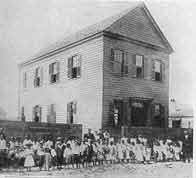Public Schools in Charleston
|

|
For Blacks who could not afford to either send their
children North to study or pay tuition at a private institution, their
only option was public school. For the 212,125 black children living in
the South Carolina, the State provided only 2,354 public schools for them.
These schools consisted mostly of Industrial
schools where children could recieve normal training as well as manual
training. |
|
This little school house...
|
|

|
| is an example of a school house. Oftentimes, the houses were so poorly constructed that the students
themselves had to help rebuild them. |
 The
education of black students was an afterthought in the eyes of the state. The
needs in the black schools were secondary to the
The
education of black students was an afterthought in the eyes of the state. The
needs in the black schools were secondary to the  white
schools. It was only after the white schools were properly funded, and the teachers
receive fair pay did the black schools recieve funding.
Black schools were not given money according to what they needed, rather the
amount allocated was decided by the money remaining in the education budget.This
expense budget would go to pay the salaries of the black teachers. Oftentimes,
the money allocated to the schools was scarcely enough to pay the salary of
the teachers much less pay for the supplies. On many occasions, the state did
not provide the funds or labor necessary to build a new school.
white
schools. It was only after the white schools were properly funded, and the teachers
receive fair pay did the black schools recieve funding.
Black schools were not given money according to what they needed, rather the
amount allocated was decided by the money remaining in the education budget.This
expense budget would go to pay the salaries of the black teachers. Oftentimes,
the money allocated to the schools was scarcely enough to pay the salary of
the teachers much less pay for the supplies. On many occasions, the state did
not provide the funds or labor necessary to build a new school.
 |
click here to find out what is going on inside the schoolhouse |
For the difficult task that Charleston public school teachers had to contend with, the level of training and pay
that they received was hardly adequate. The average annual salary of a white teacher in Charleston was $878. Their
salary per pupil was $36. 94. Black teachers were paid $297 annually. Their salary per pupil was approximately
$6.33. |
 |
Black public school teachers received substantially less training than white teachers. There were very few institutions
that were open for black teachers to receive training. Because there were so few teacher education programs, it
became extremely important that these programs train as many teachers as possible therefore the training programs
were shorter with more hurried instruction. The average black elementary school teacher received 10 weeks of intensive
training past high school which is very little compared to white teachers who receive an average of two years of
training in college. This means that not only do black teachers leave school knowing less about the methodology
of teaching but the standards for certification for black teachers had to be significantly lower than that of white
teachers. The average black teacher had more practical experience than the white teacher. Some educators argued
that while it may be important for the white teacher to receive formal training, black teachers need to learn as
fast as possible and as accurately as possible about the climate of rural class rooms. They maintain that there
is far more is learned by practice than by theory. Others argue that a teacher who has less training is less likely
to benefit from the training that she receives. They believe that Charleston's oversupply of undertrained teachers
is a negative factor contributing to the already poor public education system.
Salary Differences
Below is a table of the differences in teachers salaries of black and white teachers between 1913- 1915.
| |
White
|
Black
|
| Population of children ages 6-14 years |
145,384
|
212,125
|
| Teachers' Salaries in Public Schools (total expenditures) |
1,454,098
|
305,084
|
| Teachers' Salaries Per Child |
$10.00
|
$1.44
|


 The
education of black students was an afterthought in the eyes of the state. The
needs in the black schools were secondary to the
The
education of black students was an afterthought in the eyes of the state. The
needs in the black schools were secondary to the  white
schools. It was only after the white schools were properly funded, and the teachers
receive
white
schools. It was only after the white schools were properly funded, and the teachers
receive 







